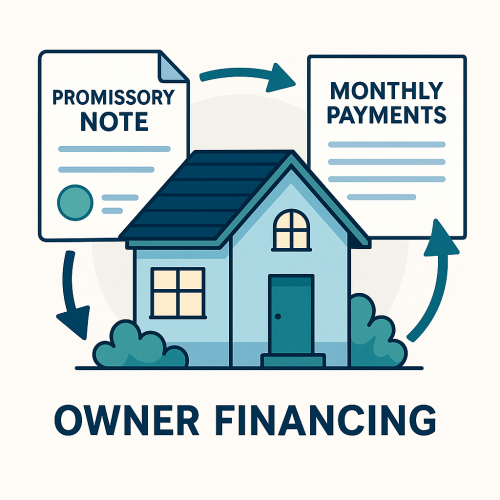When you decide to offer seller financing on your property, you’re not just making a real estate deal—you’re entering the world of mortgage lending. Under the Dodd-Frank Act, any person who offers and negotiates terms of a residential mortgage loan is deemed to be a “mortgage loan originator” and must be a licensed mortgage broker in compliance with all laws, unless one of the seller-financing exceptions apply. Understanding Dodd-Frank seller financing compliance isn’t just about avoiding penalties; it’s about protecting yourself and creating a solid foundation for your seller-financed transaction.
The Dodd-Frank Wall Street Reform and Consumer Protection Act transformed the mortgage industry in 2010, creating new rules that directly impact private sellers who offer owner financing. Whether you’re selling one property or building a portfolio, knowing these seller financing regulations will help you structure deals that work for everyone involved.
What Is Dodd-Frank and Why Does It Matter for Seller Financing?
The Dodd-Frank Act established comprehensive financial reforms designed to prevent another mortgage crisis. For private sellers, the most important component is the “Ability-to-Repay” rule, which requires creditors to verify a borrower’s ability to repay before extending credit.
This rule requires a creditor to make a reasonable, good faith determination of a consumer’s ability to repay a residential mortgage loan according to its terms. When you provide seller financing, you become the creditor, which means these rules apply to you.
The Consumer Financial Protection Bureau (CFPB) oversees these regulations, and violations can result in significant financial penalties. However, the law includes specific exemptions for certain types of seller financing arrangements.
Understanding the Two Seller Financing Exemptions
Private sellers have two distinct paths to exemption from mortgage loan originator licensing requirements. Each has different rules and restrictions that directly impact how you structure your financing deals.
The One-Property Exemption: Maximum Flexibility
If you finance only one residential property per 12-month period, you qualify for the most flexible exemption. This allows you to use balloon payments and other loan structures that are prohibited under the three-property exemption.
One-Property Exemption Requirements:
- Must be a natural person, estate, or trust (corporations and LLCs cannot use this exemption)
- Finance only one residential property per 12 months
- No negative amortization features allowed
- You must own the property being financed
- Cannot have built or acted as contractor for the dwelling in the ordinary course of business
- Fixed rate, or adjustable rate that can’t reset for ≥ 5 years and is subject to reasonable annual & lifetime caps (e.g., 2 % yearly / 6 % lifetime safe harbor).
The Three-Property Exemption: Streamlined Volume Approach
The three-property exemption allows more volume but requires stricter loan structuring. This is the most common exemption used by private sellers who want to finance multiple properties annually.
The Three-Property Rule: Your Gateway to Volume Seller Financing
If you finance three or fewer residential properties per 12-month period, you qualify for streamlined compliance requirements. However, this exemption comes with specific loan structure requirements that are more restrictive than the one-property exemption.
Requirements for Three-Property Exemption:
Property Qualification:
- Must be residential properties (1-4 family dwelling units)
- You must own the property being financed
- Properties can be primary residences, second homes, or investment properties
- Cannot have built or acted as contractor for the dwelling in the ordinary course of business
Mandatory Loan Structure Requirements:
- Full amortization to zero balance (no balloon payments allowed at any time)
- No negative amortization features
- No interest-only or other terms that would keep the loan from fully amortizing to $0
- Regular, substantially equal payments throughout the loan term
Interest Rate Requirements:
- Fixed interest rate, OR
- Adjustable rate that resets after five or more years with “reasonable annual and lifetime limitations”
- CFPB guidance suggests 2% annual and 6% lifetime caps are presumptively reasonable, but other caps may qualify if they can be justified as reasonable in light of usury ceilings and market practice
Documentation Standards:
- Written loan agreement detailing all terms
- Clear payment schedule and interest calculations
- Property disclosure requirements
- Evidence supporting your good-faith determination that the borrower can repay the loan (this is a simplified, good-faith review; the full eight-factor test applies only if you exceed three properties)
Critical Builder/Contractor Restriction: Both exemptions are lost if you built the dwelling or acted as a contractor for its construction “in the ordinary course of business.” This restriction applies even if you only financed one property in the 12-month period.
Beyond Three Properties: Full Licensing and Compliance Requirements
Sellers who finance more than three properties per year become mortgage loan originators under federal law. This means you need both proper licensing AND must comply with the Ability-to-Repay rule. Meeting Qualified Mortgage (QM) standards provides a legal safe harbor but is not required if you can demonstrate compliance with the eight ATR factors.
When You Exceed Three Properties Annually:
Licensing Requirements:
- Must obtain and maintain the MLO license required under your state’s version of the SAFE Act, either independently or under a sponsoring company
- Complete required education and testing
- Submit to background checks and continuing education
Ability-to-Repay Compliance:
- Must assess borrower’s ability to repay using the eight required factors
- Document your analysis and decision-making process
- Maintain records demonstrating compliance
Optional QM Safe Harbor:
- Following Qualified Mortgage rules provides legal protection
- Creates presumption of ATR compliance
- Simplifies documentation requirements
The Eight Ability-to-Repay Factors:
When you finance more than three properties annually, you must consider and document the borrower’s ability to repay based on these eight factors:
- Current or reasonably expected income or assets (excluding the dwelling securing the loan)
- Current employment status and employment history
- Monthly payment on the covered transaction
- Monthly payments on simultaneous loans secured by the same dwelling
- Monthly payments for mortgage-related obligations (taxes, insurance, HOA fees)
- Current debt obligations, alimony, and child support
- Monthly debt-to-income ratio or residual income
- Credit history and credit scores
Your Dodd-Frank Compliance Checklist for Seller Financing
Before Offering Seller Financing:
☐ Determine Your Annual Volume and Strategy
- Count all residential properties you’ve financed in the past 12 months
- Choose between one-property or three-property exemption strategy
- Verify you haven’t built or contracted on the properties in ordinary course of business
☐ Structure Compliant Loan Terms
- For Three-Property Exemption: Ensure full amortization to zero (no balloon payments)
- For One-Property Exemption: No negative amortization (balloon payments allowed)
- Use appropriate interest rate structure (fixed or qualifying adjustable)
- Create complete amortization schedule
☐ Prepare Documentation Systems
- Develop loan application and income verification procedures
- Create standardized loan agreement templates
- Establish borrower qualification criteria and documentation
During the Transaction:
☐ Document Borrower Qualification
- Collect evidence supporting borrower’s ability to repay
- Verify income sources and employment stability
- Review credit history and existing debt obligations
- Calculate debt-to-income ratios appropriately
☐ Structure and Document the Loan
- Ensure loan terms comply with chosen exemption requirements
- Complete written loan agreement with all required terms
- Maintain file of all supporting documents and analysis
- Record all communications and decisions
☐ Handle Property-Related Requirements
- Obtain property appraisal when appropriate
- Verify clear title and adequate insurance coverage
- Complete required property disclosures
After Closing:
☐ Establish Proper Servicing and Records
- Set up compliant payment processing systems
- Maintain accurate loan records and payment history
- Handle any escrow accounts according to regulations
- Prepare for potential future compliance audits
☐ Monitor Ongoing Compliance
- Track annual financing volume against exemption limits
- Update procedures as regulations change
- Maintain proper records retention (typically 3-5 years)
- Consider professional servicing for complex situations
Working with Professionals: When to Get Help
Seller financing compliance can be complex, especially when dealing with multiple properties or unique borrower situations. Many private sellers benefit from working with qualified professionals who understand both real estate transactions and mortgage regulations.
Consider Professional Help When:
- Financing more than two properties annually
- Approaching the three-property annual limit
- Dealing with complex borrower financial situations
- Structuring adjustable-rate financing
- Managing borrower difficulties or potential defaults
- Uncertain about builder/contractor restriction applicability
Types of Professional Support:
- Real estate attorneys specializing in seller financing
- Licensed mortgage originators familiar with seller financing exemptions
- Mortgage servicing companies for ongoing loan management
- Compliance consultants for complex regulatory questions
Red Flags: What to Avoid in Seller Financing
Understanding prohibited practices helps you avoid compliance violations and legal problems that could jeopardize your exemption status or create liability.
Prohibited Practices:
- Using balloon payments under the three-property exemption
- Creating loans with negative amortization features
- Steering borrowers toward risky or inappropriate loan terms
- Failing to maintain adequate documentation of borrower qualification
- Discriminating based on protected characteristics under fair lending laws
- Misrepresenting loan terms, risks, or your qualifications
Warning Signs of Problem Transactions:
- Borrowers who cannot provide adequate income documentation
- Requests for loan structures that don’t fit exemption requirements
- Pressure to close quickly without proper documentation and analysis
- Properties where you acted as builder or contractor in ordinary course of business
- Transactions that would exceed your annual volume limits
The Future of Your Seller-Financed Note
When you create a seller-financed note following proper Dodd-Frank compliance procedures, you’re building a valuable financial asset. Well-documented, compliant notes maintain their value and marketability whether you hold them long-term or eventually seek to sell them.
Compliance documentation serves multiple purposes: it protects you from regulatory violations, provides clear evidence of proper underwriting, and creates the paper trail that note purchasers require. Whether you choose the flexibility of the one-property exemption or the volume potential of the three-property exemption, proper compliance from the beginning ensures maximum options for your financial future.
Important Legal Disclaimer
The information provided in this article is for educational purposes only and does not constitute legal advice. Dodd-Frank regulations are complex and subject to interpretation and change. Before structuring any seller financing transaction, consult with a qualified real estate attorney or consumer finance attorney familiar with current federal and state regulations in your jurisdiction.
Take Action: Your Next Steps for Compliant Seller Financing
Dodd-Frank compliance for seller financing requires careful planning and attention to detail, but the right structure protects both you and your borrowers while creating valuable opportunities. By following the appropriate exemption requirements and maintaining proper documentation, you can confidently engage in seller financing while building assets for your future.
Ready to turn your seller-financed note into immediate cash? At YBG Funding, we specialize in purchasing properly structured, compliant seller-financed notes. Our team understands the value of notes created with proper documentation and regulatory compliance, whether they were structured under the one-property or three-property exemptions.
Whether you’re planning your first seller-financed transaction or managing an existing note portfolio, we’re here to support your success. Contact YBG Funding today for a free, no-obligation quote on your seller-financed mortgage note. Let’s discuss how proper compliance today creates valuable opportunities tomorrow.









No responses yet